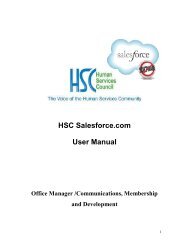BLUEPRINT
Blueprint for Neighborhoods - United Neighborhood Houses
Blueprint for Neighborhoods - United Neighborhood Houses
- No tags were found...
Create successful ePaper yourself
Turn your PDF publications into a flip-book with our unique Google optimized e-Paper software.
inadequate Kindergarten space. Doing so will ensure that Universal Pre-Kindergarten<br />
programs can continue to expand to meet demand without diverting<br />
space from Kindergarten classrooms serving children just one year older.<br />
1.6 Expand partnerships between after school programs and child welfare<br />
preventive service providers. Child welfare preventive services in after school<br />
settings provide help to families in a welcoming, familiar environment.<br />
1.7 Allow Out-of-School Time and Cornerstone programs to host child welfare<br />
preventive services. Beacon after school programs have shown that they can<br />
successfully host child welfare preventive services. This model can be applied<br />
to other after school programs.<br />
1.8 Reduce the caseload in Beacon-based child welfare preventive programs to the 12<br />
family per caseworker national average. Decreased caseloads allow social workers<br />
time to ensure that every family gets the attention it needs. This change will bring<br />
Beacon-based preventive programs in line with national standards and the caseload<br />
ratio used in other New York City child welfare preventive services programs.<br />
1.9 Contract with after school programs to offer training to parents to engage<br />
in their children’s education. After school programs maintain relationships<br />
with schools and parents. These relationships can help parents become more<br />
engaged in their children’s education.<br />
2. Quality Public Schools<br />
2.1 Incorporate elements of New York State teaching standards that require educators<br />
to facilitate parent engagement into teachers’ responsibilities. This will<br />
ensure that educators make engaging parents a priority.<br />
2.2 Require schools to send all written communications in a language parents can<br />
understand, including all written communication regarding school events and student-specific<br />
information. By sending information in a language parents can understand,<br />
schools can increase immigrant parents’ engagement with school activities.<br />
2.3 Require schools to make qualified interpreters available at parent-teacher<br />
conferences, PTA meetings and all other events or meetings at school. Making<br />
interpreters available at these important school events will ensure that all<br />
parents attending can fully participate.<br />
2.4 Inform Limited English Proficient parents that interpretation is available if they wish<br />
to speak to a school staff member. Parents often do not know this option is available.<br />
Informing them will help facilitate communication between parents and school staff.<br />
2.5 Guarantee a spot in a zoned school for every Kindergarten-aged child in New<br />
York City. New York City does not guarantee a Kindergarten spot in a school<br />
near a family’s home forcing many children to travel to Kindergarten.<br />
2.6 Sustain and build on the Multiple Pathways/Learning to Work CBO partnership<br />
model in transfer high schools and Young Adult Borough Centers. Expanding<br />
the Learning to Work model is critical to strengthening the connection between<br />
the Department of Education and community-based organizations to address<br />
the needs of high school youth at risk of not graduating.<br />
2.7 Build out structured support for post-secondary transitions in partnership with<br />
community-based organizations. The transition from high school to college is a<br />
critical process that requires special attention from educators and communities.<br />
Leveraging the expertise of community-based organizations will foster successful<br />
transitions from high school to college and careers for even greater numbers of youth.<br />
2.8 Decrease caseloads for high school guidance counselors to 200 per counselor.<br />
Guidance counselors often have caseloads as high as 400 students. Reducing caseloads<br />
will allow counselors to devote more individualized attention to each student.<br />
Blueprint for Neighborhoods 2013 4




